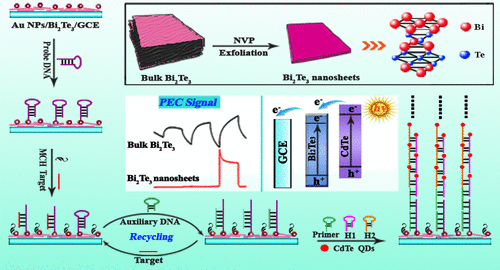当前位置:
X-MOL 学术
›
ACS Appl. Mater. Interfaces
›
论文详情
Our official English website, www.x-mol.net, welcomes your
feedback! (Note: you will need to create a separate account there.)
Highly Sensitive Photoelectrochemical Biosensor Based on Quantum Dots Sensitizing Bi2Te3 Nanosheets and DNA-Amplifying Strategies.
ACS Applied Materials & Interfaces ( IF 8.3 ) Pub Date : 2020-05-06 , DOI: 10.1021/acsami.0c04536 Yali Yuan 1 , Tao Hu 1 , Xia Zhong 1 , Minghui Zhu 1 , Yaqin Chai 1 , Ruo Yuan 1
ACS Applied Materials & Interfaces ( IF 8.3 ) Pub Date : 2020-05-06 , DOI: 10.1021/acsami.0c04536 Yali Yuan 1 , Tao Hu 1 , Xia Zhong 1 , Minghui Zhu 1 , Yaqin Chai 1 , Ruo Yuan 1
Affiliation

|
In this work, Bi2Te3 nanosheets treated with N-vinyl-pyrrolidinone showed highly sufficient and stable photocurrent for being used as a novel photoactive material. Accordingly, with CdTe quantum dots (QDs) sensitizing Bi2Te3 nanosheets, photoelectrochemical (PEC) biosensor coupling of DNA-amplifying strategies was constructed for sensitive miRNA-21 detection. Initially, the Bi2Te3 nanosheets on the electrode have conductive surface states with dissipationless electronic property, thus providing a highly stable photocurrent and a large surface-to-volume ratio. Then, with the participation of target miRNA-21 and auxiliary DNA, strand displacement amplification took place, thereby opening substantial DNA hairpins for triggering the next hybridization chain reaction (HCR). Through the HCR, long DNA tails decorated with CdTe QDs could thus be assembled on the electrode for enhancing the photocurrent of Bi2Te3 nanosheets. As a result, the proposed PEC biosensor showed a wide detection range from 10 fM to 100 pM with a detection limit of 3.3 fM, displaying a promising avenue to construct simple, ultrasensitive, and stable analytical techniques and tremendous potential in bioanalysis and early clinical diagnosis.
中文翻译:

基于量子点的Bi2Te3纳米片和DNA扩增策略的高灵敏度光电化学生物传感器。
在这项工作中,用N-乙烯基-吡咯烷酮处理的Bi2Te3纳米片显示出足够高且稳定的光电流,可用作新型光敏材料。因此,利用CdTe量子点(QD)敏化Bi2Te3纳米片,构建了DNA扩增策略的光电化学(PEC)生物传感器耦合,用于敏感的miRNA-21检测。最初,电极上的Bi2Te3纳米片具有具有无耗散电子特性的导电表面状态,因此提供了高度稳定的光电流和大的表面积体积比。然后,在靶标miRNA-21和辅助DNA的参与下,发生链置换扩增,从而打开大量的DNA发夹,以触发下一个杂交链反应(HCR)。通过HCR,因此,可以将修饰有CdTe QD的长DNA尾巴组装在电极上,以增强Bi2Te3纳米片的光电流。结果,提出的PEC生物传感器显示了从10 fM到100 pM的宽检测范围,检测限为3.3 fM,为构建简单,超灵敏,稳定的分析技术提供了广阔的前景,在生物分析和早期临床诊断中具有巨大潜力。
更新日期:2020-04-24
中文翻译:

基于量子点的Bi2Te3纳米片和DNA扩增策略的高灵敏度光电化学生物传感器。
在这项工作中,用N-乙烯基-吡咯烷酮处理的Bi2Te3纳米片显示出足够高且稳定的光电流,可用作新型光敏材料。因此,利用CdTe量子点(QD)敏化Bi2Te3纳米片,构建了DNA扩增策略的光电化学(PEC)生物传感器耦合,用于敏感的miRNA-21检测。最初,电极上的Bi2Te3纳米片具有具有无耗散电子特性的导电表面状态,因此提供了高度稳定的光电流和大的表面积体积比。然后,在靶标miRNA-21和辅助DNA的参与下,发生链置换扩增,从而打开大量的DNA发夹,以触发下一个杂交链反应(HCR)。通过HCR,因此,可以将修饰有CdTe QD的长DNA尾巴组装在电极上,以增强Bi2Te3纳米片的光电流。结果,提出的PEC生物传感器显示了从10 fM到100 pM的宽检测范围,检测限为3.3 fM,为构建简单,超灵敏,稳定的分析技术提供了广阔的前景,在生物分析和早期临床诊断中具有巨大潜力。





















































 京公网安备 11010802027423号
京公网安备 11010802027423号